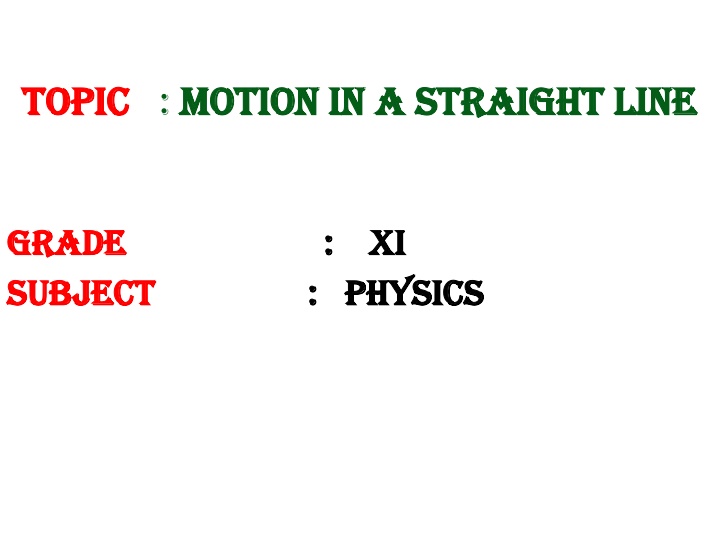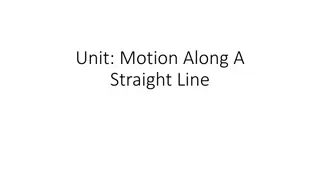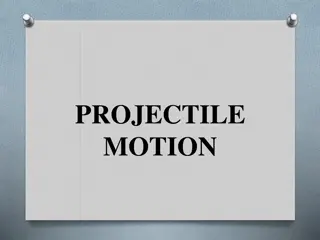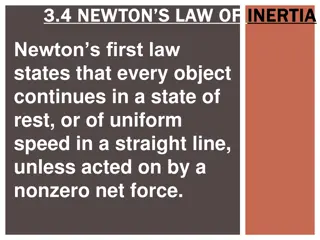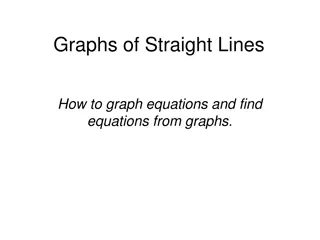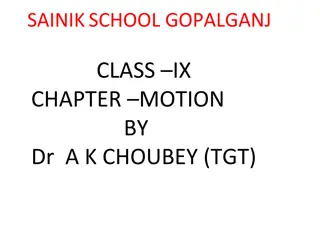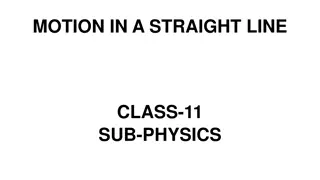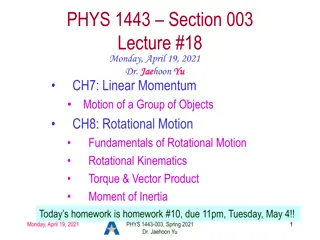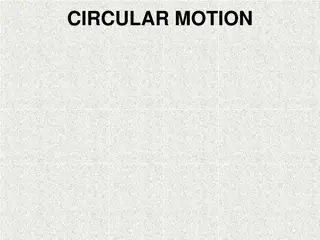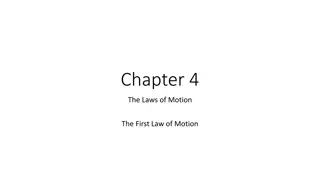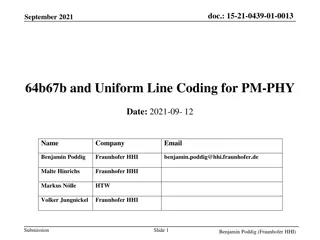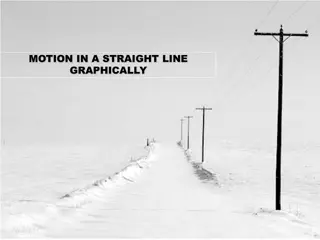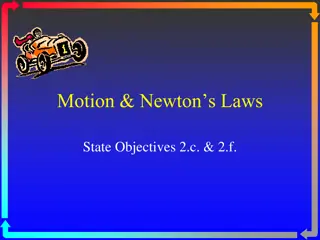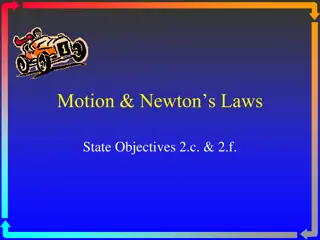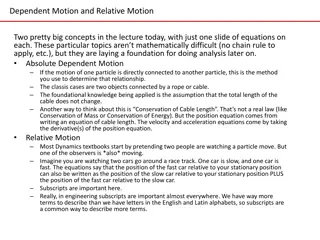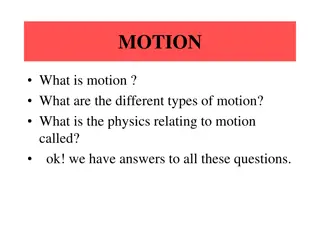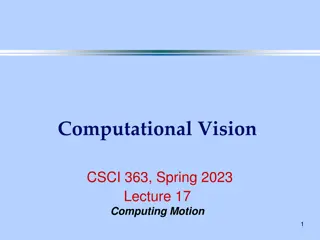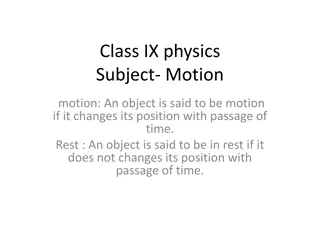Introduction to Motion in a Straight Line
Learn about the fundamental concepts of motion in a straight line in physics for Grade XI students. Understand distance, displacement, position-time graphs, average velocity, average speed, and more to enhance your comprehension of motion. Explore the intricacies of reference points, coordinates, and velocity calculations to build a solid foundation in this topic.
Download Presentation

Please find below an Image/Link to download the presentation.
The content on the website is provided AS IS for your information and personal use only. It may not be sold, licensed, or shared on other websites without obtaining consent from the author.If you encounter any issues during the download, it is possible that the publisher has removed the file from their server.
You are allowed to download the files provided on this website for personal or commercial use, subject to the condition that they are used lawfully. All files are the property of their respective owners.
The content on the website is provided AS IS for your information and personal use only. It may not be sold, licensed, or shared on other websites without obtaining consent from the author.
E N D
Presentation Transcript
TOPIC TOPIC : motion in a straight line motion in a straight line GRADE GRADE SUBJECT SUBJECT : XI : XI : PHYSICS : PHYSICS
Describing motion Describing motion To locate the position of object we require a reference point (origin) and a set of axes. The coordinates (x,y,z) describe the position of object. The coordinate system along with the clock is known as the frame of reference.
Distance: Distance: The actual path length travelled by the object is known as distance. It is Scalar quantity. Displacement: Displacement: The change in position is known as displacement. Displacement = Final position Initial position x = x2 x1 x2> x1, x is positive x2< x1, x is negative
Position Position time Graph:(x time Graph:(x- -t graph) t graph) The motion of the object can be represented by position time graph. 8 6 40 X (m) 4 30 x (m) 20 2 10 0 0 10 20 30 40 1 2 3 4 t (S) t (S) Object in uniform motion Object is at rest
8 6 Position(m) 4 2 0 1 2 3 4 Time (S) Object in non-uniform motion i.e. accelerated motion
Average velocity: Average velocity: Average velocity is defined as displacement ( x) divided by time interval ( t) It is measured in ms-1
Average Speed: Average Speed: Average speed is defined as the total path length travelled by the object divided by time interval. It is measured in ms-1
X-t graph for two children A and B returning from their school O to their houses P and Q resp. Choose the correct entries in the bracket Q P X (m) 1.(A/B) lives closer to the school than(B/A) A 2.(A/B) stars from the school earlier than(B/A) B 0 t (S) 3.(A/B) walks faster than(B/A) 4. A and B reach home at the (same/different) time. 5.(A/B) overtakes(B/A) on the road (once/twice)
Instantaneous Velocity: Instantaneous Velocity: The velocity at an instant is defined as the limit of average velocity as the time interval becomes infinitesimally small( t tends to zero) The instantaneous velocity is also defined as the rate of change of position at that instant. The instantaneous velocity is the time derivative of position.
Instantaneous Speed: Instantaneous Speed: The magnitude of an instantaneous velocity is called as instantaneous speed. Speed associated with both the velocities will 25 ms-1
Average Acceleration: Average Acceleration: Average acceleration is defined as change in velocity ( v) divided by time interval ( t) It is measured in ms-2
Instantaneous acceleration: Instantaneous acceleration: The acceleration at an instant is defined as the limit of average acceleration as the time interval becomes infinitesimally small ( t tends to zero) The instantaneous acceleration is also defined as the rate of change of velocity at that instant. The instantaneous acceleration is the time derivative of velocity.
The Position time graph x x x O t O O t t Zero Acceleration Positive Acceleration Negative Acceleration
The velocity time graph v v v0 v0 O t O t Object is moving in positive direction with positive acceleration Object is moving in positive direction with negative acceleration
v0 t t1 t2 O O -v0 -v -v Object is moving in negative direction with negative acceleration Object is moving with negative acceleration through out. Between 0 to t1it moves + x-direction and between t1to t2it moves in opposite direction.
Area under Velocity-time Graph. 40 A B v Velocity -Time Graph for object moving with constant velocity. 30 Velocity(km)/ 20 10 t Area of Rectangle OABC = OA x OC = v x t Area under Velocity-Time graph c h0 o 1 2 3 4 = Time (h) Product of velocity and time is equal to displacement. Area under Velocity Time graph is always equal to the distance travelled by an object.
Kinematic equations of uniformly accelerated motion E B v v-v0 If the object is moving with constant acceleration then inst,acceleration is equal to av.acceleration v0 A C 1.velocity-time relation 0 D t t v = v0+at This is velocity-time relation
2. Position -time relation E B v Area under v-t graph. v-v0 v0 A C A = Ar.of Rec.OACD +Ar of Tri. ACB A = (AO x OD)+ (Ac x BC) 0 D t t A = (v0x t)+ (v-v0) x t x = v0t + a t2 A = v0t + (v0+at-v0) x t A = v0t + a t2 x x0= v0t + a t2
3. Position velocity relation E B v Area under v-t graph. v-v0 Area of trapezium OABD v0 A C A = x OD (OA +BD) 0 D t t A = x t (v0+v) x = (v2-v02)/2a A = x (v-v0)/a x (v0+v) x-x0= (v2-v02)/2a A = (v-v0)x (v + v0)/2a 2a(x-x0)= v2-v02 A = (v2-v02)/2a
Home work 1.A ball thrown vertically upwards with a speed of 19.6 m/s from the top of the tower returns to the earth in 6 seconds. Find the height of the tower. 2.A car moving along the straight highway with a speed of 126 km/h ,is brought to a stop within a distance of 200 m. What is the retardation of the car and how long does it take for the car to stop?
Equations of motion by Calculus method Equations of motion by Calculus method 1. velocity-time relation. Acceleration Integrating on both sides This is velocity-time relation.
2. Position-time relation. velocity Integrating on both sides This is Position-time relation.
3.Velocity-Position relation. Integrating on both sides This is velocity-Position relation.
Relative velocity Relative velocity Consider two objects A and B moving uniformly with average velocities vA and vB along x-axis. If xA (0) and xB (0) are positions of objects A and B,respectively at time t = 0, their positions xA(t) and xB(t) at time t are given by: xA(t ) = xA (0) + vAt --------1 xB(t) = xB(0) + vBt --------2 displacement of object B w.r.t. object A is xBA(t) = xB(t) xA(t) xBA(t) = [ xB(0) xA(0) ] + (vB vA) t. ----3 Object B has a velocity vB vA w.r.t. A
The velocity of object B relative to object A is vB vA vBA= vB vA The velocity of object A relative to object B is vA vB vAB= vA vB
B 140 140 A 120 120 A 100 100 80 80 B X(m) X(m) 60 60 40 40 20 20 O 1 2 3 4 5 6 O 1 2 3 4 5 6 t(s) t(s) vA= vB vA vB = 0 vB - vA= 0 vA> vB vB - vAis negative The two objects stay at a constant distance Objects meet at a common point
140 120 A 100 80 X(m) 60 40 B 20 O 1 2 3 4 5 6 t(s) vA and vBare of opposite signs. In this case, the magnitude of vBA or vABis greater than the magnitude of velocity of A or that of B
